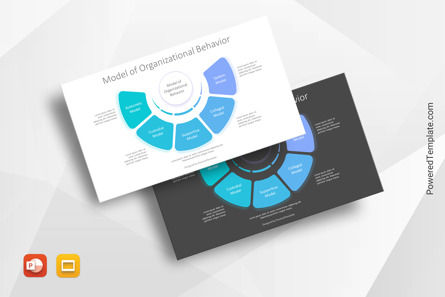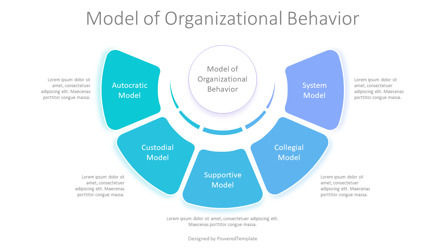99898
5 Models of Organizational Behavior - Free Google Slides theme and PowerPoint template
ID: 10879
Free for personal and commercial use with attribution required.
How to attribute the author?Unlock this file and gain access to other Premium resources.
Go Premium and Download! | Already Premium? Sign in
Free Google Slides theme and PowerPoint template
For those of you who are looking for a visual to accompany your presentations about organizational behavior, this 5 Models of Organizational Behavior diagram is just the thing. Whether in PowerPoint or Google Slides format, this diagram gives you the tools to create an engaging presentation that can illustrate the five models: hierarchical, leadership-collaborative, convergence-divergence, top-notch-bottom-up, and combination. Educate your audience on ways to manage and organize their tasks with an attractive and professional chart. After all, boring slides might be remembered – but they’ll rarely inspire action.Understanding organizational behavior can be intimidating, but it doesn't have to be! After all, it is only a way of understanding the why and how of decision-making and interaction between different people in an organization. Organizational behavior is an intriguing field, and looking into its many models helps us understand the complexities of human behavior within a larger context. Five key models in this area include: Autocratic or authoritarian, democratic or participative, supportive or enabling, laissez-faire, and bureaucratic.
- 1. Autocratic or authoritarian organizational behavior models are both popular methods of managing people, but their implementation of them is often quite different. Autocratic models demand that higher-level managers have complete control over decision-making, while authoritarian models require a slightly more collaborative effort from employees in order to determine which decisions should be made.
- 2. The democratic or participative organizational behavior model encourages individuals to have greater autonomy and self-management in their work environment. This means that employees are allowed to participate in decision-making processes, leading to more creative engagement and a sense of ownership of the company's goals.
- 3. The supportive or enabling organizational behavior model is an interesting concept for businesses to consider in order to ensure their workforce is happy and motivated. This particular model emphasizes the importance of authentically listening to employees, creating a positive working environment, and affording them support where necessary.
- 4. The laissez-faire organizational behavior model embraces the concept of individual autonomy and minimal management intervention, allowing employees to have a high degree of freedom in decision-making. This model is best suited for those organizations that are more concerned with collaboration than conformity. It has been proven to foster innovation, as a staff has the ability to take charge when necessary and take responsibility for their actions.
- 5. When it comes to organizational behavior, the bureaucratic model is one of the most effective approaches. This method prioritizes rules, regulations, and hierarchy within a business. It emphasizes obedience and order across all levels of an organization.
- - 100% editable and easy to modify
- - 2 dark and light slides to impress your audience
- - Contains easy-to-edit graphics
- - Designed to be used in Google Slides and Microsoft PowerPoint
- - PPT/PPTX format file
- - 16:9 widescreen format suitable for all types of screens
- - Includes information about fonts, colors, and credits of the free resources used.
Each has its own advantages and disadvantages that should be weighed when analyzing the best approach within a corporate setting. From strict hierarchical structures to those based on mutual collaboration, each model offers its own unique way of spurring positive change within any organization. Choosing the right organizational behavioral model can be a challenge – one that requires careful consideration and thorough research.
Template Features:
Related Items






